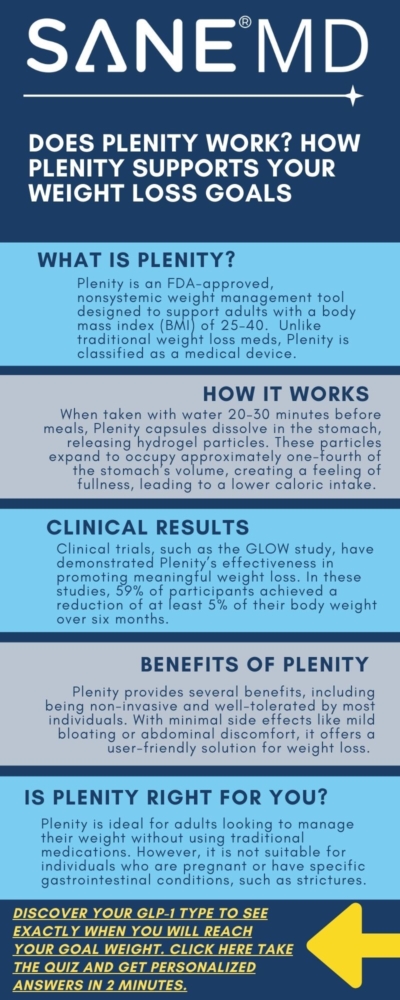Does Plenity Work As Expected Or Worse?
Dr. Matthew Olesiak, MD, is the Chief Medical Director at SANESolution, a renowned wellness technology company dedicated to providing evidence-based solutions for optimal living. Dr. Olesiak earned his medical degree from the prestigious Jagiellonian University Medical College in Kraków, Poland, where he developed a strong foundation in medicine.
Plenity is an FDA-approved medical device designed to assist overweight and obese adults in their weight loss journey. Marketed as a novel nonsystemic oral hydrogel, Plenity helps compatible users feel fuller, leading to reduced calorie intake when combined with a healthy diet and exercise. Obesity is a significant factor leading to various health issues, including coronary artery disease, highlighting the importance of effective treatment options for obesity. But does Plenity work as expected, and does it live up to the claims?
Let’s dive into the details.
Key Takeaways
Plenity’s hydrogel capsules for weight loss have emerged as a safe, FDA-approved option for weight management, offering a unique approach to supporting healthy weight loss.
Here are three key points to consider:
- Unique Mechanism of Action: Plenity’s hydrogel expands in the stomach, creating a feeling of fullness without systemic absorption, making it a nonsystemic and innovative weight management tool.
- Clinically Proven Results: Clinical trials show that Plenity helps users achieve significant weight loss when combined with a calorie-restricted diet and regular exercise, with an average weight reduction of 5-10% over six months.
- Safe and Well-Tolerated: With minimal side effects and compatibility with most healthy adults, Plenity is a reliable option for certain individuals with a BMI of 25-40 looking to manage their weight sustainably.
How Plenity Works
Plenity comes in three capsules, which should be taken with water 20-30 minutes prior to lunch and dinner. Once consumed, the capsules release gel particles made from cellulose and citric acid, which expand in the stomach, increasing the person’s stomach volume and promoting a feeling of fullness. This mechanism helps users consume smaller portions without feeling deprived. See our guide for more information on how to take Plenity.
Unlike traditional weight loss medications that decrease appetite through chemical means, Plenity’s unique mechanism of action involves physical expansion in the stomach.
Key Features and Benefits of Plenity
| Feature | Description |
|---|---|
| Mechanism of Action | Expands in the stomach to promote fullness, helping reduce calorie intake. |
| Key Ingredients | Made from naturally derived cellulose and citric acid. |
| Safety Profile | Generally well-tolerated with minimal side effects like bloating. |
| Clinical Trial Results | Helped 59% of users achieve at least 5% weight loss in 6 months when combined with diet and exercise. |
| Administration | Three capsules taken with water 20–30 minutes before meals. |
Plenity Ingredients and Safety
Plenity contains two naturally derived building blocks: modified cellulose and citric acid. The modified cellulose is cross-linked with citric acid to create a three-dimensional matrix. Each capsule contains thousands of superabsorbent hydrogel particles. When taken orally with a meal, the capsules disintegrate in the stomach, releasing the hydrogel particles. These particles occupy about one-fourth of a person’s stomach volume when fully hydrated, promoting a feeling of fullness.
Plenity is generally considered safe and well-tolerated. However, it may interfere with medication absorption and should not be taken at the same time as other medications. Plenity is not recommended for pregnant individuals or for those with a history of strictures, anatomical issues in the esophagus, or complications from previous gastrointestinal surgeries.
Clinical Trials and Effectiveness
Could Plenity help you reach your weight loss goals? It’s possible. Plenity’s efficacy was demonstrated in the GLOW study, a double-blind, placebo-controlled study involving overweight and obese adults. Participants were split into treatment and placebo groups, both following a reduced-calorie diet and exercise program.
Key findings include:
- Significantly more patients in the treatment group achieved a 5% reduction in body weight compared to the placebo group.
- On average, participants experienced a weight loss equivalent to about one-fourth of their initial body weight over six months, effectively addressing the issue of losing weight.
These results highlight Plenity’s potential as a supportive tool for chronic weight management.
Benefits of Plenity
- FDA-approved and clinically tested.
- Non-invasive and made with naturally derived building blocks.
- Supports weight loss without requiring drastic lifestyle changes.
- Offers minimal side effects, such as bloating or mild abdominal pain.
Potential Side Effects
The Plenity side effects are generally well-tolerated, but some users may experience:
- Bloating
- Changes in bowel movements
- Mild abdominal pain
If side effects persist, consult a healthcare professional.
Combining Plenity with Diet and Exercise
Plenity works best when paired with a nutritious diet and consistent exercise. By integrating a balanced eating plan and physical activity into your weight loss efforts, you can enhance the benefits of Plenity and attain sustainable results.
Patients are advised to take three capsules of Plenity along with 500 mL of water 20 to 30 minutes prior to lunch and dinner. It is essential to be properly hydrated when taking this medication. Plenity should be combined with a healthy diet of fruits and vegetables and lean proteins, plus regular activity.
Cost and Pricing
Plenity is priced at $98 for a monthly supply, though it may not be included in every insurance plan. In contrast, phentermine is approximately $15 a month, while generic topiramate costs around $20 each month.
Plenity comes in prepackaged pods containing three capsules each. It is administered with water before lunch and dinner.
Realistic Expectations
Plenity has demonstrated effectiveness in clinical trials, assisting individuals in losing weight when combined with a balanced diet and exercise. Certain users achieved an average weight loss of 6.4% of their initial body weight. This is significantly more than the placebo group. Almost 6 out of 10 people taking Plenity lost at least 5% of their body weight throughout the study, considered clinically meaningful weight loss.
However, it is essential to have realistic expectations when using Plenity. Weight loss results may vary, and Plenity should be used in conjunction with a healthy lifestyle.
Frequently Asked Questions about Plenity
When considering weight loss options like Plenity, it’s natural to have questions about its availability, effectiveness, and how it compares to other options.
This FAQ section addresses common concerns and provides clear, evidence-based answers to help you better understand Plenity and its role in weight management.
1. What is Plenity?
Plenity is a prescription weight management product designed to help adults with excess weight or obesity lose weight. It is a novel, nonsystemic, oral, superabsorbent hydrogel developed for the treatment of overweight and obese adults.
Plenity is considered a medical device, not a medicine, because it achieves its primary intended purpose through mechanical modes of action. By expanding in the stomach, it helps users feel fuller, which can lead to reduced calorie intake and support weight loss efforts.
2. Is Plenity Effective for Everyone?
Many individuals use Plenity for weight management, as it is suitable for adults with a body mass index (BMI) of 25-40. However, it is not recommended for individuals with eating disorders, pregnant patients, or those with conditions affecting the small intestine.
Patients self-administered Plenity should follow their healthcare provider’s guidance to maximize benefits.
3. Is Plenity Being Discontinued?
Plenity is not being discontinued. It remains a widely available option for individuals seeking prescription-based support for weight management.
To ensure uninterrupted access, consult your healthcare provider or check with your local pharmacy about current availability.
4. What Is the Most Effective Weight Loss Pill Over the Counter?
Although Plenity requires a prescription, over-the-counter weight loss aids like Orlistat (sold as Alli) are commonly used. While these products can help with modest weight loss by reducing fat absorption, their effectiveness typically does not match prescription medications like Plenity.
Always consult a healthcare provider to determine the most appropriate option for your needs.
5. How Effective Is Plenity for Weight Loss?
Many individuals want to know if Plenity works, and the answer is “yes,” when used as directed. Plenity has demonstrated effectiveness in clinical trials, helping participants achieve meaningful weight loss when combined with a reduced-calorie diet and regular physical activity.
On average, users experienced a reduction of 5-10% of their initial body weight over six months, with many finding the product instrumental in their weight loss journey.
6. How Long Does It Take Plenity to Work?
Most individuals begin noticing weight loss within the first few weeks of using Plenity, provided they adhere to the recommended diet and exercise plan.
Significant changes often occur over three to six months, making Plenity a viable option for gradual, sustainable weight loss.
Conclusion
Plenity offers a promising solution for overweight and obese adults seeking a safe, effective way to manage their weight. By combining the benefits of diet, exercise, and this oral superabsorbent hydrogel, users can potentially achieve their goals with minimal side effects. For more information, consult a healthcare professional or visit the FDA’s official page on Plenity





